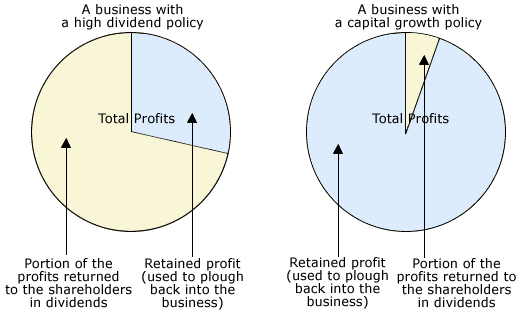Dividend policy
A | B | C | D | E | F | G | H | I | J | K | L | M | N | O | P | Q | R | S | T | U | V | W | X | Y | Z
The dividend policy theories of an enterprise is a plan of action to be followed whenever you decide about the distribution of dividends. The policy should be considered taking into account two basic objectives: to maximize the benefit of the owners of the company and provide sufficient funding.
1. All profits are distributed. The benefit-sharing ratio is 100% based on the idea that all you want to shareholders are dividends. Managers, who need their own funding, should convince shareholders that the investment projects will provide increases in their wealth, thus encouraging them to invest in the company. In any case, companies often do not follow this distribution policy.
2. Not distributed dividends. It is the opposite to the previous policy, and based on that given the tax and transaction costs exist, dividends are a luxury that neither the shareholder nor businesses can afford (one euro is worth more to the company that it , less tax for the shareholder). Despite the argument, very few companies follow this policy of no dividends.

3. Both fixed on profits. Of total annual earnings the company distributes a fixed percentage. This policy, more logical than the previous ones, is unusual in business, because the benefits are a random variable, so will the dividends, which often adversely affect the stock price (increase in economic risk company.
4. Dividend as waste. The residual theory of dividends suggests that companies should undertake all investments that increase the wealth of shareholders, ie those with a positive NPV. Therefore, any excess cash should be returned to shareholders via dividends or repurchase its shares. The problem underlying this theory is that if the profits or investment opportunities vary from year to year in strict compliance with this theory would imply a variation of the dividends, which would increase risk and, therefore, the return demanded by shareholders. As a result this policy will not usually be followed strictly by the companies, although many of them the rate used to establish a framework for the distribution of dividends in the long term.
5. Stable dividend policy . Formerly, many companies paid a constant dividend if it seemed clear that future profits were sufficient to keep it that way. A corollary of this policy was an attempt to avoid having to reduce dividends. Because inflation has pushed up the value of benefits has emerged called "policy of steady growth rate, in which the policy framework marks a growth rate of profits and tries to match it. It is played with the reserves to offset the bad years dividend (distributed under the same) or to accumulate excess undistributed profits in the good. This type of policy tends to provide stability in the price, even if the upward or downward movement of the benefits appear to be durable, the company will reconsider this policy.
Extraordinary dividends, the periodic release of bonus shares, etc., Are adjustment mechanisms to ease the stiffness of a constant dividend policy. Must be taken not to make a dividend erratic. Dividends are set in line with expected cash flows and are based on long-term benefits on the one hand, and dividends from the previous period, on the other. So in the short term, dividends tend to receive a smoothing in order to avoid frequent changes. This can be reconciled with the notion of the information contained in dividends that managers seem to use as a signal indicative of long-term yields. Hence the need to follow a stable policy in the dividend distribution policy that seem to follow most of the companies.
6. Dividend arbitrary or erratic. Each year a dividend that does not follow any of the above policies. This policy, to call in some way, is followed by companies that are adrift in the market and have failed to stabilize in the same.
- Dividend introduction
- Dividend policy
- Dividend formula
- Dividend factors
- Dividend forms
- Dividend Payment
- Dividend reinvestment plans
- Be sure of dividends
- Dividend yield
- Why investing on dividends
All rights reserved
information advertisement legal
Part of Enciclopedia Financiera Group
Disclaimer: Information on this site is only for informational purposes. Always consult a professional advisor before investing.